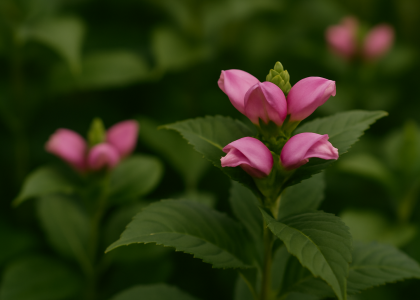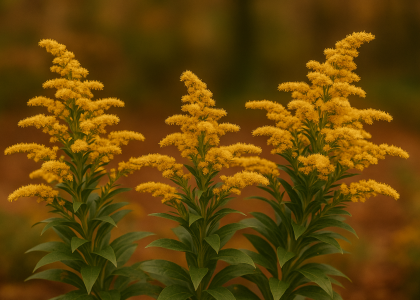Smoke Bush (Cotinus coggygria), also known as European Smoketree, is a stunning deciduous shrub known for its striking, smoky plumes that appear in late spring and early summer. With its bold, colorful foliage, unique flower clusters, and versatility, Smoke Bush is a standout in any garden. Whether you're looking for a specimen plant, a colorful shrub for mixed borders, or a plant to create dramatic autumn hues, Smoke Bush offers year-round interest with minimal care. This guide will walk you through everything you need to know about planting, caring for, and propagating Smoke Bush, with expert tips to help it thrive in your garden.
What is Smoke Bush?
Smoke Bush (Cotinus coggygria) is a versatile, deciduous shrub or small tree that is renowned for its fluffy, smoke-like flower clusters that resemble wisps of smoke. These unique flower structures, combined with vibrant foliage that turns brilliant red, orange, or yellow in the fall, make Smoke Bush an eye-catching feature in the landscape. The plant is available in several cultivars, each with distinct flower colors and foliage patterns, making it a versatile addition to gardens of all sizes.
Key Features of Smoke Bush:
- Flower Color: Pink, Purple, Red, Yellow (depending on variety)
- Foliage Color: Green in spring and summer, turning red, orange, or purple in fall
- Height: 10 to 15 feet (depending on cultivar)
- Width: 8 to 12 feet
- Blooming Season: Late Spring to Early Summer
- Hardiness Zones: 4-8
- Special Features: Dramatic fall color, unique flower clusters (smoke-like appearance), drought-tolerant
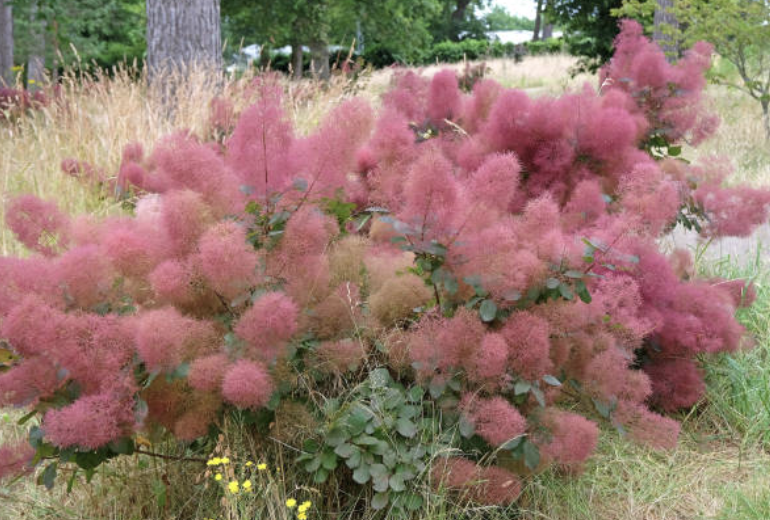
Where to Plant Smoke Bush
Smoke Bush thrives in full sun but can tolerate light partial shade. It is a hardy plant that does well in a variety of soil types, though it prefers well-draining soil. Smoke Bush is perfect for gardeners looking for a plant that is both easy-care and dramatic, providing year-round interest. It works well in a range of garden settings, from cottage gardens to modern landscapes.
Ideal Planting Locations:
- Specimen Plant: Due to its dramatic flowers and foliage, Smoke Bush is an excellent specimen plant in the center of your garden or as a focal point in a bed.
- Mixed Borders: Plant Smoke Bush among other shrubs and perennials to provide contrast and texture, especially with plants that have contrasting colors or textures.
- Hedges or Screens: Smoke Bush can also serve as an informal hedge or screen, providing privacy with its dense growth.
Expert Tip: For maximum flowering and vibrant fall color, plant Smoke Bush in a sunny spot with well-draining soil. Avoid areas where water tends to accumulate, as it prefers dry to moderately moist conditions.
How to Plant Smoke Bush
Planting Smoke Bush correctly ensures a healthy start and abundant blooms. Follow these steps for the best results:
- Best Time to Plant: Plant Smoke Bush in early spring or early fall, ensuring it has time to establish its roots before extreme temperatures arrive.
- Planting Hole: Dig a hole that is twice as wide as the root ball but only as deep. This will allow the roots to spread easily and establish strong growth.
- Soil: Smoke Bush adapts to various soil types, including sandy, loamy, and clay soils, as long as they are well-drained. It does not do well in constantly wet or boggy conditions.
- Mulching: Apply a 2-inch layer of mulch around the plant's base to help retain moisture, suppress weeds, and maintain consistent soil temperatures.
Expert Tip: Water the plant deeply during the first few months after planting to establish strong roots. Once established, Smoke Bush is fairly drought-tolerant and requires minimal watering.
Smoke Bush Care: Keeping Your Plant Thriving
While Smoke Bush is a low-maintenance plant, proper care ensures it remains healthy and vibrant throughout the growing season.
Light Requirements:
Smoke Bush thrives in full sun, where it can receive at least 6 hours of direct sunlight each day. In partial shade, it will still grow but may produce fewer flowers and have a less vibrant fall color.
Watering:
Once established, Smoke Bush is drought-tolerant and only needs watering during periods of extended drought. However, during the first growing season, water regularly to help the plant establish a strong root system.
Expert Tip: Water deeply, but infrequently, to encourage deep root growth and strong plant structure. Avoid overwatering, as Smoke Bush does not like its roots sitting in water.
Soil and Fertilizing:
Smoke Bush is adaptable to a wide range of soil conditions. It grows best in well-draining soil but can tolerate a variety of soil types, including poor, rocky soils. It does not need much fertilizer and generally thrives without it. If the plant is growing slowly or seems weak, you can apply a slow-release balanced fertilizer in the spring.
Expert Tip: Avoid over-fertilizing, as this can lead to excessive vegetative growth with fewer flowers. A light application of compost or organic matter in the spring is typically all that is needed.
Pruning Smoke Bush
Pruning Smoke Bush is important to maintain its shape, improve air circulation, and encourage new growth. Here’s how to prune:
- When to Prune: Prune Smoke Bush in early spring, before new growth begins. Avoid pruning in the fall, as this can affect the plant's winter hardiness.
- How to Prune: If the plant is overgrown or has dead wood, cut back the oldest stems to the ground to rejuvenate the plant. For shaping, trim back branches by one-third. If you prefer a more tree-like form, selectively remove lower branches to create a single trunk.
Expert Tip: Smoke Bush flowers on new wood, so pruning it back in early spring will not remove the flowers for the season. This rejuvenates the plant and encourages better blooms.
Pests and Problems
Smoke Bush is generally pest-resistant, but it can occasionally experience some problems:
- Aphids: These small pests may appear on new growth. If you notice them, wash them off with a strong stream of water or use insecticidal soap.
- Powdery Mildew: This fungal disease can develop in humid conditions. To prevent it, ensure good air circulation and avoid overhead watering.
Expert Tip: Keep an eye out for pests in early spring and treat any infestations promptly. Also, ensure the plant has good air circulation and avoid overcrowding to minimize disease risk.
Propagation: How to Grow New Smoke Bush Plants
You can propagate Smoke Bush by softwood cuttings in late spring or early summer. Here’s how:
- Take Cuttings: Take 6-8 inch cuttings from non-flowering, softwood growth. Remove the lower leaves, leaving a few leaves at the top.
- Prepare the Cuttings: Dip the cut ends of the cuttings in rooting hormone to promote root development.
- Rooting: Place the cuttings in a pot filled with well-draining soil and keep them in a warm, shaded location. After a few weeks, roots should begin to develop.
Expert Tip: Keep the soil moist but not soggy. You can also use a humidity dome or plastic cover to maintain moisture and improve the chances of successful rooting.
Types of Smoke Bush
There are several varieties of Smoke Bush, each offering unique flower colors and foliage characteristics:
- ‘Grace’: Known for its large, purplish-pink flowers and vibrant fall color. It grows to about 10-12 feet tall. Zones 4-8.
- ‘Golden Spirit’: A golden-leaf variety with yellow foliage and pink flowers. It grows to about 8 feet tall. Zones 4-8.
- ‘Velvet Cloak’: Features deep burgundy-purple leaves and pink flower plumes. It grows to about 10 feet tall. Zones 4-8.
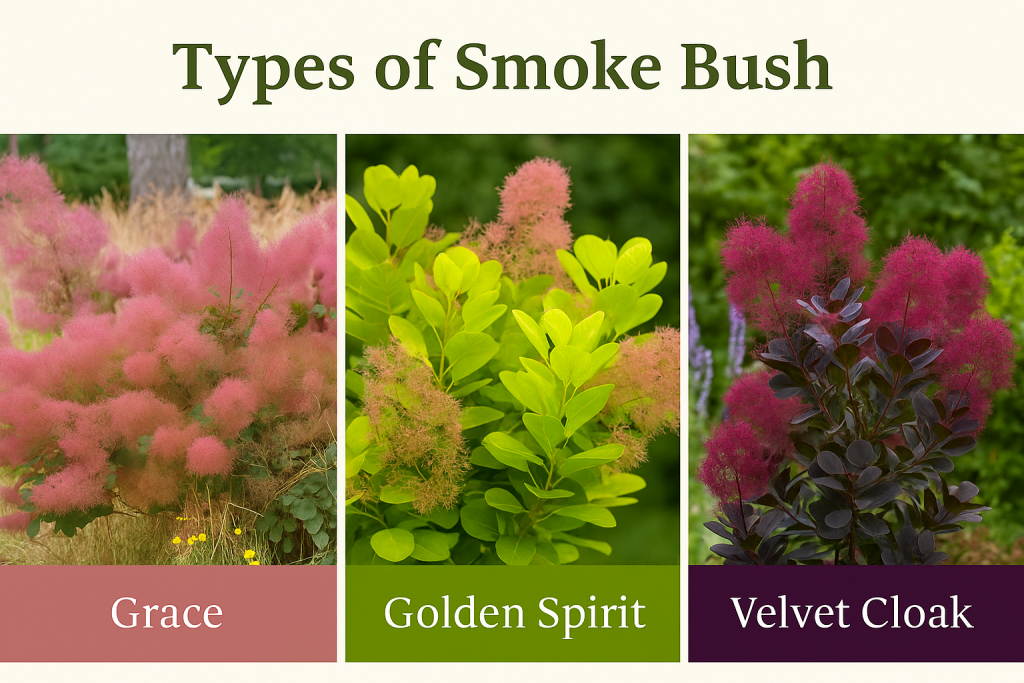
Companion Plants for Smoke Bush
Pair Smoke Bush with plants that complement its dramatic look and enhance your garden:
- Black-eyed Susan (Rudbeckia): Its bright yellow flowers contrast beautifully with Smoke Bush’s purple or red leaves.
- Russian Sage (Perovskia atriplicifolia): A drought-tolerant perennial with silvery foliage and purple flowers that pair beautifully with Smoke Bush.
- Lavender: A fragrant, drought-tolerant plant that complements Smoke Bush's colors and thrives in similar growing conditions.
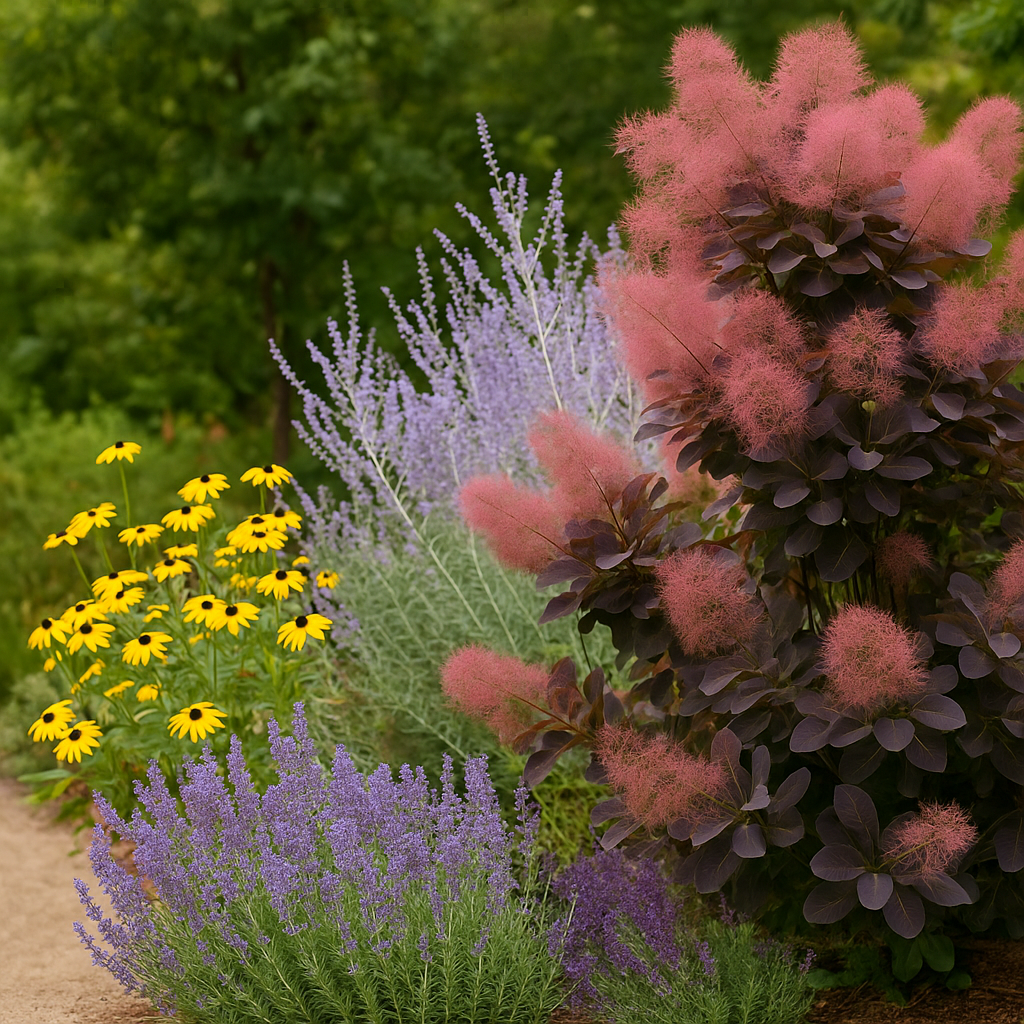
FAQ: Common Smoke Bush Questions
Why isn’t my Smoke Bush blooming?
Ensure that the plant is receiving full sun and has well-draining soil. If the plant is pruned too late in the season, you may have removed flower buds. Prune in early spring to encourage blooming.
How do I prevent Powdery Mildew on my Smoke Bush?
Ensure good air circulation around the plant by spacing it properly. Avoid overhead watering and remove any affected leaves to help prevent the spread of mildew.
Enjoy Smoke Bush in Your Garden
Smoke Bush is a versatile and stunning shrub that adds year-round beauty to your garden. With its striking flower plumes, vibrant fall foliage, and easy care requirements, Smoke Bush is a great addition to any landscape. By following the tips and care instructions in this guide, you can enjoy a healthy, thriving Smoke Bush that will provide color, texture, and interest for years to come.



